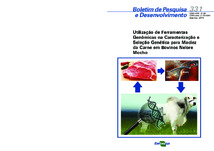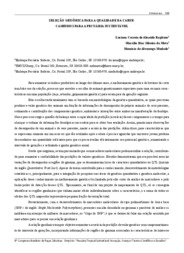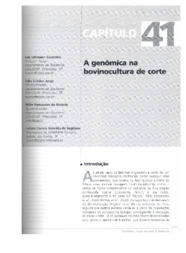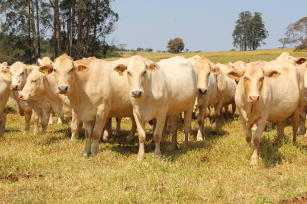Researchers create "dictionary" for cattle genes
Researchers create "dictionary" for cattle genes
A recent study conducted by the researcher Luciana Regitano's team, from Embrapa Southeastern Livestock (São Carlos, SP) managed to improve the translation of what is written in the bovine genome, that is, the relationship between genes and the traits that they express, such as meat tenderness, amount of fat, etc. The genome can be understood as a book that indicates what the cell needs to produce. Before that, many genes had not been not decoded, were unknown or their relevance was unknown. The results were published by Nature.
The data obtained will allow several advances that will inform from cattle breeding and genetic improvement programs to the development of animals that offer meats with customized details such as pre-determined tenderness and flavor.
The work, known as functional annotation of the bovine genome, was conducted by the postdoctoral scholarship holder Marcela Maria de Souza, advised by Regitano. She built a "dictionary" of sorts, with all the bovine genes that work as transcription factors, that is, they codify proteins that activate or block the expression of other genes, which also defines how the effect of such genes will "show" in the meat.
The researcher Luciana Regitano talks about research on bovine genome in Brazil
Before such results, the research resorted to the annotation of genetic material of other species to draw parallels with cattle. Luciana Regitano reports that they used databases on humans and mice. As they related such results with other results from the project "Molecular bases of Nelore beef quality", funded by the São Paulo State Research Support Foundation (Fapesp), the Embrapa studies identified differences in the expression of the genes related to meat quality traits.
The "translation" of bovine genes
To more easily understand the meaning of the discovery, the Embrapa researcher proposes the analogy of imagining the DNA as a book. "Imagine that you had to translate a book from an unknown language into yours. There is a sequence of letters that are the bases. Given letters can represent genes or not. Bovine genome DNA has not been completely translated yet, that is, most of it still is in an incomprehensible language", she explains. According to her, even the "portions without genes" are considered important, because they can regulate gene function.
Currently there is evidence of which cattle genes can be transcription factors (which codify proteins that regulate gene expression) and how they will produce proteins. Before the so-called in silico prediction (obtained in a computational simulation) based on known models used to be made.
Marcela studied these genes and updated the "dictionary" of human genes that are transcription factors. Based on that, she looked up correspondents in bovines. For each correspondent, she searched the literature for experiments that confirmed that the genes codify transcription factors.
"There are segments of this book that are still in an incomprehensible language, but she translated, checked and verified corresponding ones between humans and bovines where there is evidence of being transcription factors, like in human beings", Luciana Reginato details. "For instance, we looked for DNA variations that are important to have the animal produce better meat and offer greater efficiency of food use", she informs.
The research works with a gigantic volume of data, the so-called big data. One of the biggest involved challenges is to filter what is interesting and remove what is not interesting for each study in particular. "With Marcela's research, we can focus our attention in the most interesting parts. We want to find factors that regulate tenderness and we already have the most important data set to look into such variations", informs Regitano.
"It is as if we had to locate a person in a given city in the world, but we did not know where to find them. Marcela's research indicated the continent, the country and the state where the city is located. Now the pathway to locate the person is closer", compares the scientist.

Research represents advance for the Nelore breed
The work of analyzing expression related to the alleles (each one of the possible forms of the same gene) comprised Marcela Maria de Souza's PhD project advised by the researcher Luciana Regitano, from Embrapa Southeastern Livestock. "We were able to identify some genes that had already been previously associated with important animal production traits, which present the majoritarian expression of one or allelle or another", asserted Souza. She has recently been hired by the University of Iowa (Uiowa), in the United States, to where she moved at the end of 2018.
"The great thing about it is that we used data that had been previously generated by the theme project "Molecular Bases of Nelore beef quality", funded by Fapesp, to investigate allelic expression, a research field that has been recently gaining momentum. Very little is known in bovines when compared with humans and mice", the researcher remarks. According to her, the study managed to identify genes with the pattern in bovines, more specifically in Nelore cattle, which is the main breed in the Brazilian herd.
"The identification of important genes for animal production that have monoalellic expression, that is, only one copy of which is expressed, can contribute to increasing the accuracy of breeding programs and our work is the first one to describe several genes with this pattern in the Nelore breed", she concludes.
Photo: Ana Maio
Translation: Mariana Medeiros
Ana Maio (MTb 21.928/SP)
Embrapa Southeastern Livestock
Press inquiries
pecuaria-sudeste.imprensa@embrapa.br
Phone number: +55 16 3411 5734/5625
Further information on the topic
Citizen Attention Service (SAC)
www.embrapa.br/contact-us/sac/






